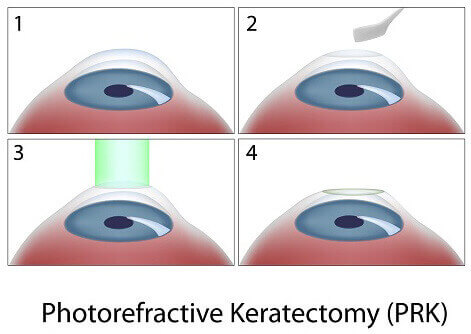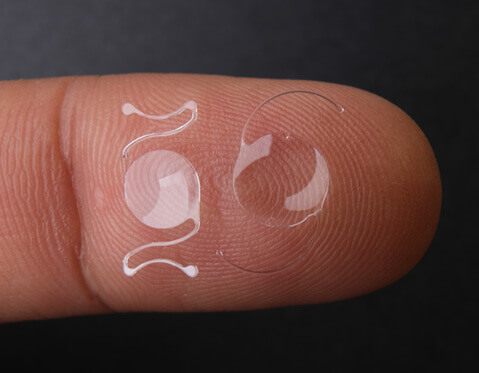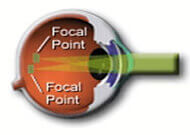Alternatives to LASIK are PRK and LASEK. These procedures are preferred over LASIK in some situations where the patient’s corneas are thin or where lifestyle predisposes the eye to trauma, like soldiers and boxers.

PRK (photorefractive keratectomy) is a type of refractive surgery, like LASIK, to correct myopia (nearsightedness), hyperopia (farsightedness) and astigmatism.
PRK was the first type of laser eye surgery for vision correction and is the predecessor to the popular LASIK procedure. Though PRK recovery takes a bit longer than recovery from LASIK eye surgery, PRK is still commonly performed and offers advantages over LASIK for some patients.
Like LASIK and other types of laser eye surgery, PRK works by reshaping the cornea using an excimer laser, allowing light entering the eye to be properly focused onto the retina for clear vision.
The main difference between PRK and LASIK is that in LASIK surgery, a thin, hinged flap is created on the cornea to access the treatment area; whereas in PRK, the cornea’s entire epithelial (outer) layer is removed to expose the area and no flap is created. For both PRK and LASIK, the excimer laser then sculpts the stromal (deeper) layer of the cornea to correct your refractive error.

A variation of PRK, called LASEK (Laser Epithelial Keratomilieusis), is also available. Instead of removing the outer epithelial layer of the cornea as with PRK, LASEK involves lifting the epithelial layer (using a surgical instrument called a trephine), preserving it during surgery and then replacing it on the eye’s surface at the end of the procedure. A bandage contact lens is placed over it. This preserved epithelial layer acts as a human bandage contact lens. It helps to reduce inflammation and discomfort during the initial few days of healing.
LASEK has decreased in popularity due to the slower recovery of vision compared with PRK, as the replaced epithelial layer takes longer to recover in LASEK than the growth of a new epithelial layer in PRK.

In Refractive Lens Exchange (RLE) the natural lens of the eye is removed and replaced with an intraocular lens (IOL) to correct refractive errors (nearsightedness, farsightedness, need for reading glasses). RLE is sometimes called Clear Lens Exchange (CLE), Clear Lens Extraction (CLE), and Refractive Lens Replacement (RLR).
The natural lens functions like a camera lens to focus images onto the retina (like the film in a camera). It is flexible in younger people under 40 years of age. However, it loses its ability to focus with age, leading to presbyopia and the need for bifocal or reading glasses. When the natural lens turns cloudy it is called cataracts. When this happens it impairs a person´s ability to see at all distances even with the best pair of glasses. Cataract extraction with intraocular lens is necessary to restore vision.
People who are nearsighted, farsighted, or presbyopic can see clearly as long as they wear glasses or contact lenses. Some people do not like the hassles of wearing glasses or contact lens, especially those who like water sports and outdoor activities. Refractive Lens Exchange can be a good option for them.
In RLE, the lens removal is done using a similar method as that for cataract removal. An intraocular lens(IOL) of pre-calculated power is then inserted to replace the natural lens. The surgery is done as an out-patient procedure. Currently, there are five options for IOLs: Monofocal IOL for distance, Monovision monofocal IOL, ReSTOR®, ReZoom TM, Crystalens TM.
Monofocal IOL for distance is similar to the IOL used in cataract removal for years with excellent track records. Both eyes are corrected for distance. The patient needs reading glasses.
Monovision monofocal IOL is a method where one IOL corrects for distance vision (dominant eye) and another IOL corrects for near vision. The patient´s brain adjusts to using the dominant eye for distance and the other for close up. This choice is best for patients who have worn monovision contact lenses.

Astigmatic Keratotomy (AK) is a refractive surgical procedure that is used to correct astigmatism.
When the shape of the cornea is more curved in one direction than the other, light entering the cornea focuses in several points within the eye resulting in blurry and distorted vision.
To treat astigmatism with AK, incisions are strategically placed on the steepest part of the cornea, causing it to relax and become more spherical or round. This allows light to focus more precisely on the retina, causing vision to become sharper and clearer. AK takes minutes to perform and can be used alone or in conjunction with other refractive procedures.